
Question:
Examine the photograph and construct a Venn diagram to organize your answer to the following questions:
a) What properties are found only in the flame?
▶️Answer/Explanation
Ans: Produces light/incandescent.
b) What properties do both the seedlings and the flame possess?
▶️Answer/Explanation
Ans: Both use oxygen in combustion/respiration; both produce carbon dioxide in combustion/ respiration.
c) What properties are found only in the seedling?
▶️Answer/Explanation
Ans: Growth; bends towards the light; heredity; response to the environment; homeostasis.
Question:
What properties do the seedlings possess that are missing from the flame, and that lead us to say that only the seedlings are alive?
▶️Answer/Explanation
Ans: Growth; homeostasis; response to stimuli; cell respiration; heredity.
Symmetry in patterns
Symmetry generates obvious patterns. These are seen in the form of many organisms. The concept of form is explored in Chapter 2.
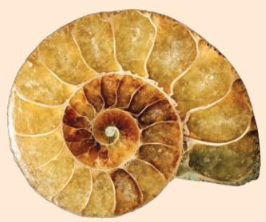
Question:
Can you find examples in that chapter of these types of symmetry:
a) bilateral symmetry, where the left and right sides are mirror images of each other?
▶️Answer/Explanation
Ans: Bilateral: giraffe; hummingbird; butterfly; honey bee; millipede; human; fly; cicada; crab; ant.
b) radial symmetry, where rotation around a fixed point does not change the overall shape?
▶️Answer/Explanation
Ans: Radial: apple; sea star.
c) helical symmetry, where rotation along a screw axis also causes translation?
▶️Answer/Explanation
Ans: Helical: DNA; chloroplast in Spirogyra.
The shell of the mollusc Nautilus consists of a series of whorl sections.
Question:
a) Is the structure of the shell helical or spiral?
▶️Answer/Explanation
Ans: Spiral.
b) Does the shell have a symmetrical pattern?
▶️Answer/Explanation
Ans: Bilateral symmetry; plane of symmetry with left and right halves that are mirror images; spiral is not symmetrical.
Question:
What patterns are there in the timing of life cycles?
Patterns do not only exist in the distribution of variables in space, but also over time. Consider the examples shown here and in each case discuss what the advantages of the pattern shown in the timing of the life cycle.
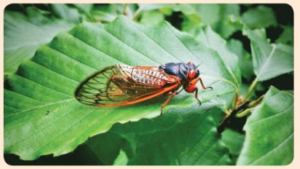
The population of the insect Magicicada tredecim varies over time. Mature adults, known as cicadas, are consistently present in habitats in low numbers, however, every 13 or 17 years a population explosion occurs.
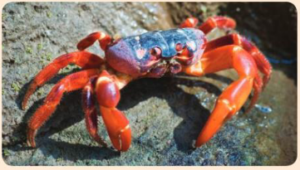
Red crabs (Gecarcoidea natalis) live in large numbers in the forests of Christmas Island. Males and females migrate to the coast and mate. All females release their fertilised eggs into the water at the turn of the high tide during the last quarter of the moon, in November or December.
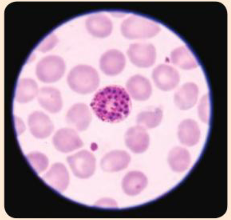
The parasites that cause malaria have a very short life cycle. They invade red blood cells, reproduce inside them and then burst out and invade other red blood cells. This gives rise to a pattern in the symptoms of malaria with a cycle of coldness and shivering then fever and sweating that takes two days if the malaria is caused by Plasmodium vivax or three days if Plasmodium malariae is he cause.
▶️Answer/Explanation
Ans: Magicicada reduces predation by synchronously emerging every 13 or 17 years; because too many emerge for predators to consume; predators cannot rely on Magicicada as a source of food because it is too infrequent; 13/17 is a prime number so predators with a 2/3/4/5 year cycle will not always coincide with Magicicada emergence.
Gecarcoidea: too many eggs released for predators to eat; many therefore survive; males can shed their sperm when eggs are in the water; increasing the chance of fertilization.
Plasmodium: tertian and quartan fevers; parasite might benefit from synchronizing its life cycle with the human 24–hour circadian rhythm; fevers usually occur in the evening; Anopheles mosquitos tend to bite and suck out blood in the evening; Plasmodium (gameto– cytes) are sucked out with the blood; gametocytes may emerge into the blood in the evening; to maximize chances of dispersal; at the same time causing evening fevers; Plasmodium vivax might be reproduced faster than Plasmodium malariae hence 2/3 day cycles; immune system might not control the parasite as effectively if it remains inside body cells apart from brief periods every 2nd/3rd day; so Plasmodium synch– ronizes its emergence; overwhelming the capacity of the immune system; cause of tertian and quartan fevers not known even after 100 years of research.

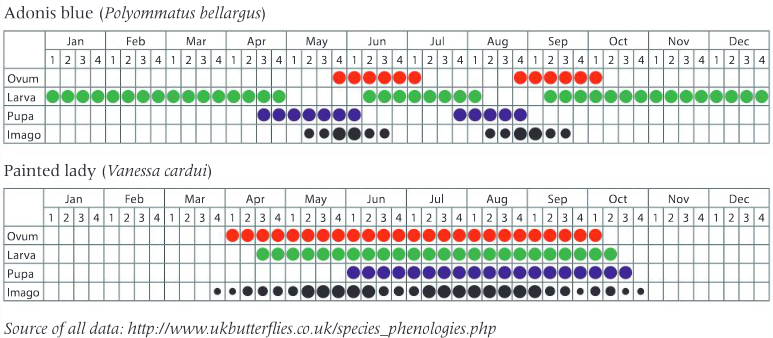
Question:
Describe the life cycle of the Brimstone butterfly, including the timing of stages in the cycle.
▶️Answer/Explanation
Ans: Adults survive through the winter; mate and lay eggs in May/June/early summer; larvae hatch and grow in June/July/mid–summer; pupation in late July/early August; adults emerge from pupae in August.
Question:
Explain the differences between the data for the Brimstone and the Adonis blue.
▶️Answer/Explanation
Ans: Adonis blue completes two life cycles in a year whereas the Brimstone only completes one; Adonis blue overwinters as a larva whereas the Brimstone overwinters as an adult.
Question:
Explain the differences between the data for the Brimstone and the Painted lady.
▶️Answer/Explanation
Ans: No Painted Lady of any stage present in UK in winter whereas Brimstones are present as adults; Painted lady is a migrant whereas Brimstone remains in the UK; Painted lady flies to warmer climates/flies south in October; returns from the south in March/April/May/June/July.
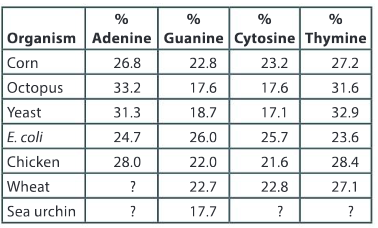
Question:
Determine the sum of the percentages for the four bases in corn.
▶️Answer/Explanation
Ans: 100%
Question:
Compare the relative amounts of guanine in the different organisms.
▶️Answer/Explanation
Ans: Variable; ranges from 17.6 to 26.0
Question:
Determine the ratio of guanine to cytosine in:
a) octopus
▶️Answer/Explanation
Ans: Octopus: 1 to 1
b) chicken.
▶️Answer/Explanation
Ans: Chicken: 22.0 to 21.6 = 1.02 to 1
Question:
Deduce the approximate relationship between the amount of guanine and the amount of cytosine in all organisms.
▶️Answer/Explanation
Ans: Approximately equal.
Question:
Determine the ratio of adenine to thymine in:
a) chicken
▶️Answer/Explanation
Ans: Chicken: 28.0 to 28.4 = 0.986 to 1
b) corn.
▶️Answer/Explanation
Ans: Corn: 26.8 to 27.2 = 0.985 to 1
Question:
Deduce the approximate relationship between the amount of adenine and the amount of thymine in all organisms.
▶️Answer/Explanation
Ans: Approximately equal.
Question:
Suggest why these ratios are not exact in all of the organisms.
▶️Answer/Explanation
Ans: Error in measurement.
Question:
Predict the expected percentage of adenine for wheat.
▶️Answer/Explanation
Ans: Assuming adenine is equal to thymine it should be 27.1/subtracting the other percentages from 100 gives an expected percentage of 27.4%
Question:
Predict the expected percentage of adenine, cytosine and thymine for the sea urchin.
▶️Answer/Explanation
Ans: Cytosine = 17.7% as it will be equal to the guanine percentage; adenine plus thymine are 64.6; so they are each 32.3%
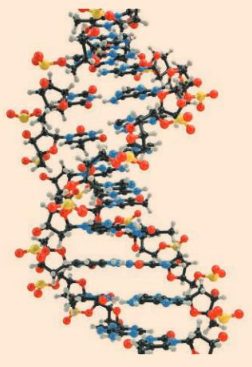
Looking at the picture of the DNA helix:
Question:
Describe the pattern of orientation of the two strands.
▶️Answer/Explanation
Ans: Run in opposite directions/anti–parallel.
Question:
Describe the pattern of the major and minor grooves.
▶️Answer/Explanation
Ans: Major and minor grooves alternate; both follow a right–handed helical path.
The words KAYAK, REDDER and ROTATOR are examples of palindromes because they read the same forwards as backwards. An example of a palindrome in DNA is:
5 ́ GAATTC 3 ́
3 ́ CTTAAG 5 ́
Question:
Why is this regarded as palindromic, even though neither of the strands have base sequences that read the same forwards as backwards?
▶️Answer/Explanation
Ans: Because the sequence on one strand is found on the other strand in the opposite direction/one strand is palindromic of the other.
Question:
Does a palindromic sequence have an extra type of symmetry?
▶️Answer/Explanation
Ans: Rotational symmetry.
Question:
Palindromic base sequences in DNA have some important roles. Can you find one?
▶️Answer/Explanation
Ans: Restriction enzymes bind to palindromic sites; methyl groups may be added to palindromic sites to active/deactivate a gene.
Question:
What would happen if a cell divided before it had replicated its DNA?
▶️Answer/Explanation
Ans: There would only be one copy of some genes so the two daughter cells would not receive complete copies of the genome.
Question:
What would happen if a cell divided repeatedly without enlarging?
▶️Answer/Explanation
Ans: The cell would become smaller and smaller.
Question:
Zygotes perform a series of cell divisions without any cell enlargement between the divisions. How can this happen?
▶️Answer/Explanation
Ans: The egg cell has a large amount of cytoplasm; so the zygote also has a large amount of cytoplasm; so repeated division do not result in cells with too little cytoplasm.
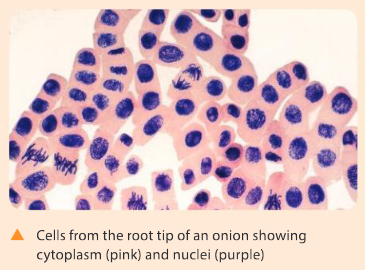
Question:
Six onion root tip cells in the micrograph are in metaphase. Which cells are they?
▶️Answer/Explanation
Ans: They are the cells with chromosomes on the equator.
Question:
How many cells are in anaphase?
▶️Answer/Explanation
Ans: One cell is in anaphase.
Question:
Cells in telophase are in pairs, they have relatively small nuclei and the chromosomes are not fully spread out so the nucleus still appears lumpy. How many pairs of cells in telophase can you identify?
▶️Answer/Explanation
Ans: Three cells.
Question:
Cells in prophase have strands or lumps visible in the nucleus because DNA molecules are being coiled up to form condensed chromosomes. How many cells in prophase can you see? Which of these is closest to the start of prophase and which is closest to the end?
▶️Answer/Explanation
Ans: At least six cells are in prophase; lower left is a cell that is well advanced though prophase; hard to say which cell is closest to the start of prophase because the transition in appearance from
interphase is gradual.
Question:
The relative lengths of time of the four phases of mitosis can be deduced from the numbers of cells in each phase. Which phase takes the shortest and which takes the longest time?
▶️Answer/Explanation
Ans: Anaphase takes the shortest; prophase takes the longest.
Question:
the the explanations written in the text all valid?
▶️Answer/Explanation
Ans: The question should be ‘Are the explanations written in the text all valid’. The expected answer is that all of the explanations are valid (though unproven).
Question:
Which of the explanations do you think is most important as a reason for larger organisms being multicellular? Debate this with other students and try to achieve consensus.
▶️Answer/Explanation
Ans: Surface area–volume constraints are often cited as the reason for cells not becoming very large, but nucleus cytoplasm ratio may also be significant as large structures such as muscle fibres are multinucleate. There are also arguments for the importance of physical strength, for example the larger size of plant than animal cells with plant cells strengthened by the cell wall.
Question:
Can you think of any other explanations?
▶️Answer/Explanation
Ans: Students may be able to think of alternative explanations.
i. Are there any consequences of being unicellular that are an advantage?
▶️Answer/Explanation
Ans: No need for cell to cell communication; or cell adhesion; or transport between cells.
ii. Calculate surface area to volume ratios for 1, 10 and 100 mm diameter cubes. What happens to the ratio as cubes get larger? What are the implications for limits to cell size given the functions that cell membranes perform?
▶️Answer/Explanation
Ans: 1 mm: 6 mm2 to 1 mm3 = 6; 10 mm: 600 mm2 to 1,000 mm3 = 0.6; 100 mm: 60,000 mm2 to 1,000,000 mm3 = 0.06;
the surface area to volume ratio gets smaller as cubes get larger; when the length of side of a cube increases ten–fold, the surface area to volume ratio decreases by one order of magnitude; increasing difficulty with exchange processes across the cell surface membrane.
Question:
What is the advantage of asexual reproduction for organisms that are successful because they are well adapted to their environment?
▶️Answer/Explanation
Ans: Successful cells can pass on their combination of genes to offspring; their offspring are therefore also likely to be well adapted.
Question:
What is the disadvantage of asexual reproduction to a species during a period of environmental change?
▶️Answer/Explanation
Ans: Existing combination of genes cease to be well adapted because of changes to the environment; no new combinations of genes generated by asexual reproduction; no/little variation generated; nothing for natural selection to work on; evolution/adaptation to new conditions very slow/too slow.
Summative assessment
Cyclical patterns in the cicada life cycle
Question:
a) Outline the properties that are shared by all living things.
▶️Answer/Explanation
Ans: Metabolism/reactions catalyzed by enzymes; growth/increase in size; respiration/release of energy from food; excretion/removal of waste products; homeostasis/maintaining internal conditions different from those in the environment; reproduction/producing offspring; inheritance/genes passed on to offspring; response to stimuli.
b) Design a test that could be performed to determine if the yellow objects in the image below are insect eggs or candy.
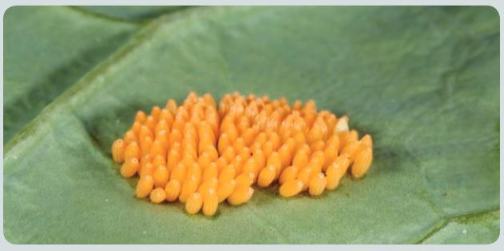
▶️Answer/Explanation
Ans: Measure oxygen consumption; measure carbon dioxide production; measure heat production; observe to see whether larvae hatch/grow/feed.
Question:
The periodical cicada Magicicada septemdecim has a life cycle where the insect spends a prolonged period of time underground developing. While underground, it goes through five periods of
life known as instars. At the end of each instar period, it sheds its outer skin. The fifth instar emerges from underground and sheds its skin to become the short lived adult. At the point of the emergence, a burst in the adult population above ground occurs. The graph shows the percentage of underground nymphs that are in each stage. Using the information in the graph, answer the
following questions.
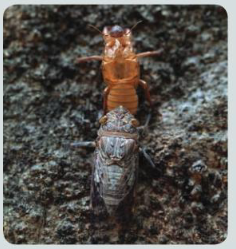
Adult cicada emerging from the final nymph stage
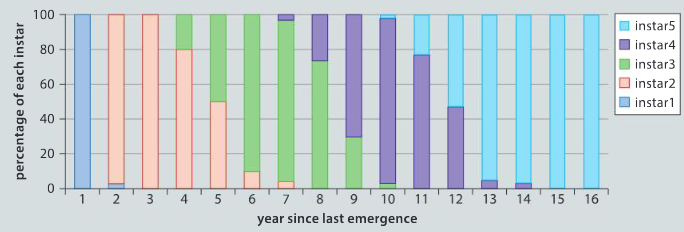
Changes in percentage of larvae in each instar stage over a 16-year period
▶️Answer/Explanation
Ans: 50%
▶️Answer/Explanation
Ans: Pupation; emergence of imagos/adults/cicadas.
▶️Answer/Explanation
Ans: 17 years; adults must appear in year 17 and produce eggs; only instar 1 larvae are alive in year 1.
▶️Answer/Explanation
Ans: Graph would show sharp spikes in numbers every 17th year; if there was an emergence in 2011 there would be the next one in 2028; and the previous one would have been in 1994.
▶️Answer/Explanation
Ans: More caterpillars survive; and eat more oak leaves; so oak trees become defoliated.
▶️Answer/Explanation
Ans: Greater survival of cicada nymphs under immature trees; as there is less pathogenic fungus; adult cicadas might preferentially lay eggs under immature trees; due to genetic programming/instinct.
▶️Answer/Explanation
Ans: Mole numbers increase when there are fifth instar cicada nymphs; moles move to areas with more fifth instar cicada nymphs; mole numbers highest in years 13 to 16 of the cicada cycle.
▶️Answer/Explanation
Ans: Increasing damage from year 1 to year 16; as the nymphs become larger so need more food; or damage decreases as more and more cicadas have died/been eaten; least damage in year 17.
Investigating proportions of the human forearm
Question:
The golden ratioflis an irrational number approximately equal to 1.62. It is argued to appear many times in human knowledge systems like geometry, art and architecture. The Ancient Greek
mathematician Euclid wrote about it 2,300 years ago, though he did not use the “golden ratio” name. Some erroneously claim that the ratio applies in some situations where it doesn’t, such as in the Nautilis shell, and others state that it doesn’t apply when it does.


▶️Answer/Explanation
Ans: a + b = 8; (a + b)/ a = 8/5 = 1.6; close to the golden ratio but not the exact 1.62
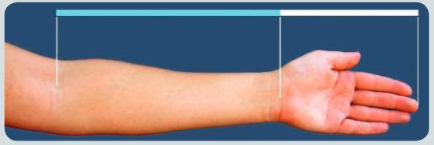
▶️Answer/Explanation
Ans: Names of classmates in row headings; at least ten classmates measured or all classmates if there are fewer than ten in the class; column headings as in the text book table; with distance units added for measure a and measure b; each measurement is in a separate cell on the table; measurements recorded to the nearest millimetre; all ratios correctly calculated.
Investigating patterns in the leaf distribution in plants
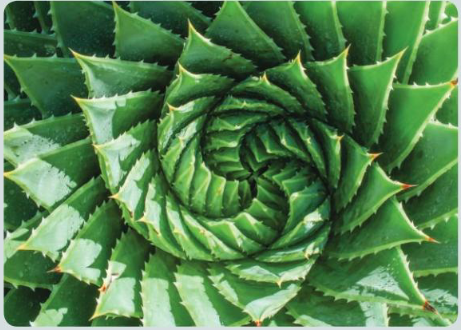
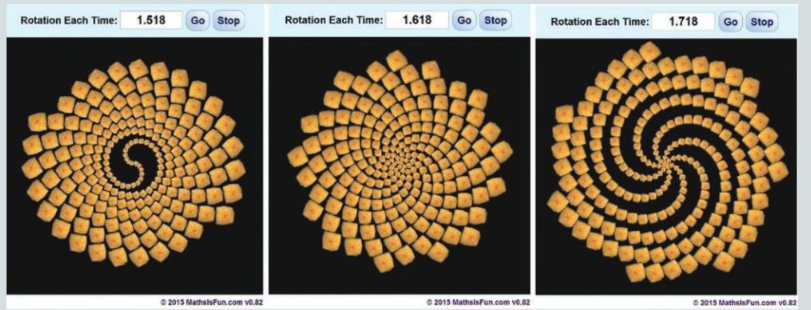
Question:
Use the three images generated from the simulator to explain the leaf pattern in the Aloe plant.
▶️Answer/Explanation
Ans: Answers could include these points:
• Location of leaves as far apart from each other as possible;
• yet minimizing the total space taken up is favorable for capturing sunlight;
• the three patterns differ in terms of leaf packing;
• the centre image has the maximum density of leaves per unit area;
• when entering a rotation factor into the simulator, the golden ratio yields the pattern seen in the aloe leaves;
• the fixed angle of 137.5 yields this pattern;
• the second leaf is placed as far as possible from the first;
• and the third is placed at a distance farthest from both the first and the second leaf;
• as the number of leaves increases, the divergence angle eventually converges to a constant value of 137.5 degrees.
Using genetic patterns to protect against poaching
Read the passage and answer the questions that follow.
Question:
State how similar human beings are genetically.
▶️Answer/Explanation
Ans: Very similar; more than 99.9% of coding sequences in human DNA are the same; variation is greatest for satellite sequences but they are arguably not very significant in human traits.
Question:
Distinguish between genes and microsatellites.
▶️Answer/Explanation
Ans: Genes are coding sequences whereas microsatellites are non–coding; genes have a function such as coding for the amino acid sequence of proteins whereas microsatellites have no obvious function; genes are longer than microsatellites; microsatellites are repeated sequences whereas genes are non–repeating (usually).
Question:
a) Explain why microsatellites are useful in tracing geographic origin.
▶️Answer/Explanation
Ans: Very variable; differences develop rapidly; populations that separated relatively recently can be distinguished.
b) Once the origin of the ivory is determined, suggest what specific actions might be taken to limit elephant poaching.
▶️Answer/Explanation
Ans: Identify areas where poaching is most prevalent; police bans on poaching more intensely in such areas; trace trade routes and prosecute traffickers in illegal ivory; develop policies where local populations gain more from the presence of live elephants than from poached ivory.
c) Suggest specific situations in which microsatellite sequences may be used.
▶️Answer/Explanation
Ans: Students can research the possibilities: a research search term to find out more could be: ‘the use of microsatellite sites in conservation/ classification/forensics’ and if conservation is chosen, answers such as these could be given:
• Determine relatedness and reducing inbreeding in captive breeding programs.
• Identify origin of whale meat – whaling is tolerated in some jurisdictions but not others so test meat samples to determine which population they come from.
